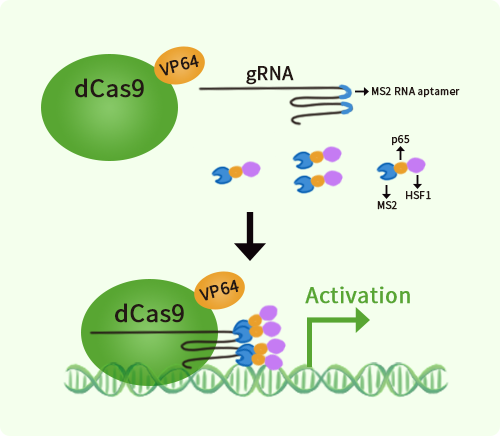Human Dysadherin (FXYD5) activation kit by CRISPRa
CAT#: GA110025
FXYD5 CRISPRa kit - CRISPR gene activation of human FXYD domain containing ion transport regulator 5
Find the corresponding CRISPRi Inhibitor Kit
USD 1,290.00
2 Weeks*
Specifications
| Product Data | |
| Format | 3gRNAs, 1 scramble ctrl and 1 enhancer vector |
| Symbol | FXYD5 |
| Locus ID | 53827 |
| Kit Components | GA110025G1, FXYD5 gRNA vector 1 in pCas-Guide-CRISPRa GA110025G2, FXYD5 gRNA vector 2 in pCas-Guide-CRISPRa GA110025G3, FXYD5 gRNA vector 3 in pCas-Guide-CRISPRa 1 CRISPRa-Enhancer vector, SKU GE100056 1 CRISPRa scramble vector, SKU GE100058 |
| Disclaimer | The kit is designed based on the best knowledge of CRISPa SAM technology. The efficiency of the activation can be affected by many factors, including nucleosome occupancy status, chromatin structure and the gene expression level of the target, etc. |
| Reference Data | |
| RefSeq | NM_001164605, NM_001320912, NM_001320913, NM_014164, NM_144779, NR_028406 |
| Synonyms | DYSAD; HSPC113; IWU1; KCT1; OIT2; PRO6241; RIC |
| Summary | This gene encodes a member of a family of small membrane proteins that share a 35-amino acid signature sequence domain, beginning with the sequence PFXYD and containing 7 invariant and 6 highly conserved amino acids. The approved human gene nomenclature for the family is FXYD-domain containing ion transport regulator. Mouse FXYD5 has been termed RIC (Related to Ion Channel). FXYD2, also known as the gamma subunit of the Na,K-ATPase, regulates the properties of that enzyme. FXYD1 (phospholemman), FXYD2 (gamma), FXYD3 (MAT-8), FXYD4 (CHIF), and FXYD5 (RIC) have been shown to induce channel activity in experimental expression systems. Transmembrane topology has been established for two family members (FXYD1 and FXYD2), with the N-terminus extracellular and the C-terminus on the cytoplasmic side of the membrane. This gene product, FXYD5, is a glycoprotein that functions in the up-regulation of chemokine production, and it is involved in the reduction of cell adhesion via its ability to down-regulate E-cadherin. It also promotes metastasis, and has been linked to a variety of cancers. Alternative splicing results in multiple transcript variants. [RefSeq curation by Kathleen J. Sweadner, Ph.D., sweadner@helix.mgh.harvard.edu., Sep 2009] |
Documents
| Product Manuals |
| FAQs |
| SDS |
Resources
Other Versions
| SKU | Description | Size | Price |
|---|---|---|---|
| KN403917 | FXYD5 - KN2.0, Human gene knockout kit via CRISPR, non-homology mediated. |
USD 1,290.00 |
{0} Product Review(s)
Be the first one to submit a review






























































































































































































































































 Germany
Germany
 Japan
Japan
 United Kingdom
United Kingdom
 China
China
